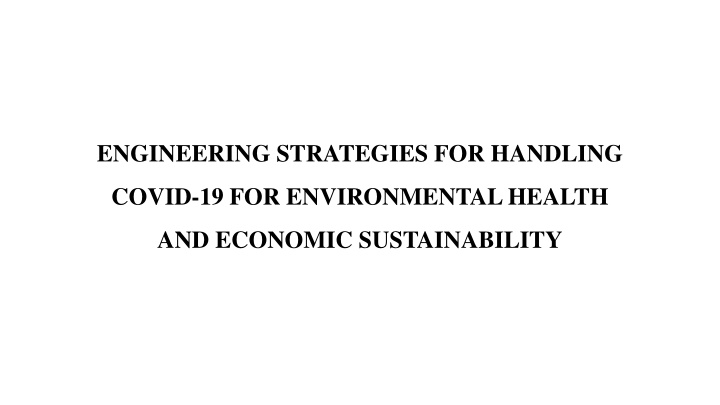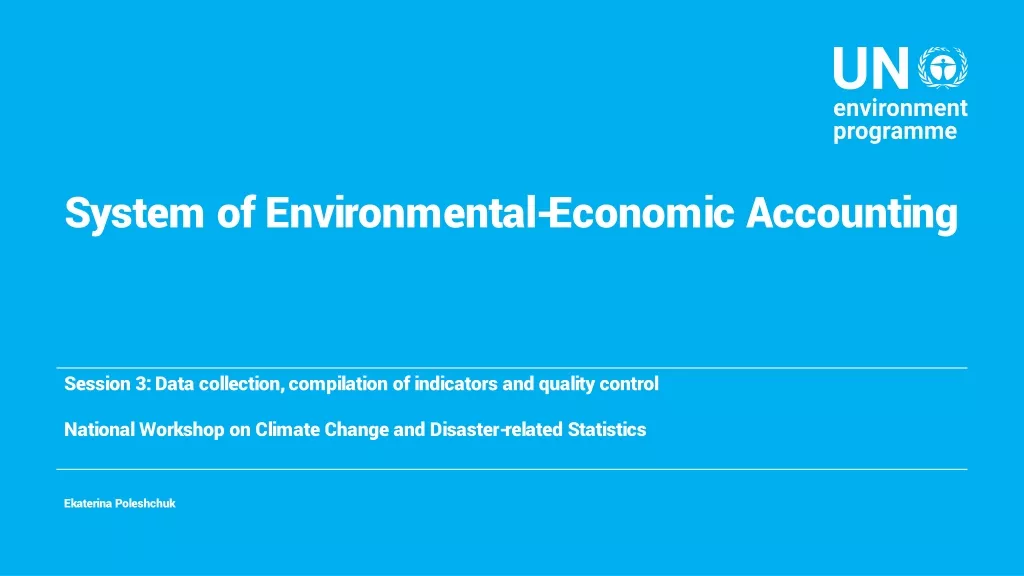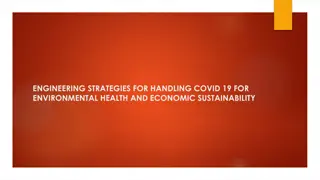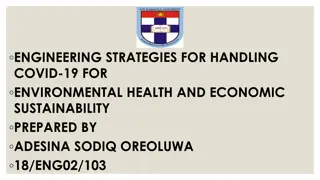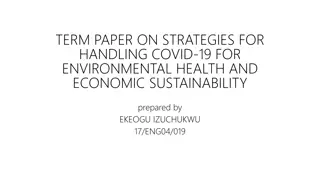Engineering Strategies for Handling COVID-19: Environmental Health and Economic Sustainability
This content focuses on implementing effective engineering strategies to combat the challenges posed by COVID-19 with a special emphasis on environmental health and economic sustainability. It addresses the essential measures and approaches necessary for mitigating the impacts of the pandemic on both public health and economic stability, offering valuable insights into navigating these interconnected issues.
Download Presentation

Please find below an Image/Link to download the presentation.
The content on the website is provided AS IS for your information and personal use only. It may not be sold, licensed, or shared on other websites without obtaining consent from the author.If you encounter any issues during the download, it is possible that the publisher has removed the file from their server.
You are allowed to download the files provided on this website for personal or commercial use, subject to the condition that they are used lawfully. All files are the property of their respective owners.
The content on the website is provided AS IS for your information and personal use only. It may not be sold, licensed, or shared on other websites without obtaining consent from the author.
E N D
Presentation Transcript
ENGINEERING STRATEGIES FOR HANDLING COVID-19 FOR ENVIRONMENTAL HEALTH AND ECONOMIC SUSTAINABILITY
PREPARED BY EGBOCHUKWU EBENEZER UZOCHIWARA 17/ENG01/008 CHEMICAL ENGINEERING
ABSTRACT This term paper gives a detailed account on the engineering strategies for handling covid-19 for environmental and economic sustainability. A new strain of coronavirus which originated in Wuhan, Hubei province, China, in late December 2019, has caused a cluster of cases of an acute respiratory disease, which is referred to as coronavirus disease 2019 (COVID-19). According to media reports, more than 200 countries and territories have been affected by COVID-19, because major outbreaks of it have occurred in the United States, central China, western Europe, and Iran. Coronaviruses are the subfamily of Orthocoronavirinae, in the family Coronaviridae, order Nidovirales, and realm Riboviria. Coronavirus could be used as a weapon designed as other viruses existing. Hence, covid-19 has been seen to have severe effects on the environmental health and economic sustainability.
According to WHO, Environmental health as it relates to health as all the physical, chemical, and biological factors external to a person and all the related behaviours, environmental health consists of preventing or controlling disease, injury, and disability related to the interactions between people and their environment. Economic sustainability refers to practices that support long-term economic growth without negatively impacting social, environmental, and cultural aspects of the community. Now the precept of handling is to simply control the virus so as not to out of hand but in this concept, we limit ourselves to the engineering strategies to handle the pandemic for environmental health and economic sustainability. The effects of covid-19 on the environmental health has been seen to be drastically with respect to the elemental themes of environmental health, which includes: outdoor air quality, surface and ground water quality, toxic substances and hazardous wastes, homes and communities, infrastructure and surveillance, and global environmental health. The effects of covid-19 on the economic sustainability are seen on the financial system of a nation that displays only minor fluctuations in output growth and exhibits a consistently low inflation rate.
Some of the engineering strategies given with case study for this issue are seen to be the use of artificial intelligence, the use of ventilators and mathematical modelling to handle this issue. Furthermore, for the successful completion of the term paper, I was able acquire more knowledge in the engineering strategies for handling economic sustainability and environmental health due to the coronavirus. Lastly, the term paper was totally successful because the set-out objectives were achieved after taking certain precautions and observations realized. KEYWORDS Health And Environment Stability Economy Sustain
CHAPTER ONE INTRODUCTION CORONAVIRUS AND EXISTENCE
INTRODUCTION CORONAVIRUS AND EXISTENCE A new strain of coronavirus which originated in Wuhan, Hubei province, China, in late December 2019, has caused a cluster of cases of an acute respiratory disease, which is referred to as coronavirus disease 2019 (COVID-19). According to media reports, more than 200 countries and territories have been affected by COVID-19, because major outbreaks of it have occurred in the United States, central China, western Europe, and Iran. On 11 March 2020, the World Health Organization characterized the spread of COVID-19 as a pandemic. As of 6 April 2020, the number of COVID-19 infected people reached 1.31 million, the death toll was 77,200 and the number of patients recovered was 276,189, maximum number of patients found in the U.S. 366,906.
Coronaviruses are the subfamily of Orthocoronavirinae, in the family Coronaviridae, order Nidovirales, and realm Riboviria. They are enveloped viruses with a positive-sense single- stranded RNA genome and a nucleocapsid of helical symmetry. The genome size of coronaviruses ranges from approximately 27 to 34 kilobases, the largest among known RNA viruses. The name coronavirus is derived from the Latin corona, meaning "crown" or "halo", which refers to the characteristic appearance reminiscent of a crown or a solar corona around the virions (virus particles) when viewed under two-dimensional transmission electron microscopy, due to the surface being covered in club-shaped protein spikes. Coronaviruses (CoV) are a large family of viruses that cause illness ranging from the common cold to more severe diseases such as Middle East Respiratory Syndrome (MERS-CoV) and Severe Acute Respiratory Syndrome (SARS-CoV). A new strain of coronavirus (SARS-CoV-2) causes Coronavirus disease 2019, or COVID-19.
COVID-19 was declared a pandemic by the WHO on 11 March 2020. Some coronaviruses are zoonotic, meaning they are transmitted between animals and people. Detailed investigations found that SARS-CoV was transmitted from civet cats to humans, and MERS-CoV from dromedary camels to humans. Several known coronaviruses are circulating in animals that have not yet infected humans. Common signs of infection include respiratory symptoms, fever, cough, shortness of breath, and breathing difficulties. Standard recommendations to prevent the spread of infection include regular hand washing, covering mouth and nose when coughing and sneezing, thoroughly cooking meat and eggs, and avoiding close contact with anyone showing symptoms of respiratory illness such as coughing and sneezing. The recommended distance from other people is 6 feet, a practice more commonly called social distancing.
Figure 1: CORONAVIRUS CORONAVIRUS AS A BIOLOGICAL WEAPON Diseases considered for or known to be used as a weapon include anthrax, Ebola, Marburg virus, plague, machupo, Psittacosis, Japanese B encephalitis, Rift Valley fever, yellow fever, and smallpox, also including coronavirus if the cure or vaccine is found.
HOW TO PROTECT YOURSELF To reduce the risk of spread of coronavirus, members of the public are advised to adhere to the following measures: Wash your hands regularly with soap under running water. Cover your mouth and nose properly with handkerchief or tissue paper when sneezing and/or coughing. You may also cough into your elbow if a handkerchief is not available. Avoid close contact with anyone showing symptoms of respiratory illness such as coughing and sneezing. Avoid self-medication, report to the nearest health facility when you experience any of the above- mentioned symptoms. Healthcare workers are always advised to observe standard infection prevention and control measures when attending to patients and take a travel history. As the situation is evolving, this advisory will be updated as more information becomes available.
TERMINOLOGIES ASSOCIATED WITH CORONAVIRUS A pandemic (from Greek , pan, 'all' and , demos, 'people') is an epidemic of disease that has spread across a large region, for instance multiple continents, or worldwide. Epidemic: This a widespread occurrence of an infectious disease in a community at a particular time.
CORONAVIRUS AS A PANDEMIC SITUATION A pandemic is an epidemic occurring on a scale that crosses international boundaries, usually affecting people on a worldwide scale Pandemics can also occur in important agricultural organisms or in other organisms. A disease or condition is not a pandemic merely because it is widespread or kills many people; it must also be infectious. For instance, cancer is responsible for many deaths but is not considered a pandemic because the disease is neither infectious nor contagious. The World Health Organization (WHO) previously applied a six-stage classification to describe the process by which a novel influenza virus moves from the first few infections in humans through to a pandemic. This starts with the virus mostly infecting animals, with a few cases where animals infect people, then moves through the stage where the virus begins to spread directly between people and ends with a pandemic when infections from the new virus have spread worldwide. In February 2020, a WHO spokesperson clarified that "there is no official category [for a pandemic]".
CORONAVIRUS AND ITS EFECTS CAUSED IN NIGERIA As part of attempts to limit the spread of Covid-19, governments have instituted lock-down measures and banned public gatherings. Lagos, Africa s largest city with 21 million people, is attempting to do the same. With 11 confirmed cases, by far the most in Nigeria, the state government has asked schools to shut down and banned public gatherings of more than 50 people, particularly religious congregations. In the event of more cases, tougher measures will likely follow. Given Lagos standing as Nigeria s economic nerve centre, the threat of a highly contagious viral outbreak in a state where 20 million people are squeezed into land mass that s about the size of Indianapolis (population: 870,000), is grim. But shutting down Lagos on any scale will likely be an uphill task for the government, the city is defined by non-stop activity and a hustle and bustle spirit that perennially draws thousands of Nigerians from other states in search of better economic opportunities. it s a city of ingenuity and chutzpah which most people need to be able to survive in an overwhelmed urban system. this means Lagos is often defined by lawlessness as people seek solutions for their daily life.
Beyond cultural and behavioural nuances, the government will also be up against the might of religion Nigeria s Christian population is the largest in Africa and is projected to double by 2060. Lagos itself is home to some of the country s most well-attended mega-churches with hundreds of branches that welcome millions in congregation every Sunday. As such, attempting to enforce a ban on religious gatherings likely puts the state government at odds with powerful religious leaders whose co-operation is fundamental given their influence. Yet, there are already signs of potential conflict between the government and influential clergymen: the Christian Association of Nigeria (CAN) says a ban on religious gatherings is not necessary. We believe we will never get to the point of having to ban all services and churches will be grounded, CAN s Lagos chairman has said. These issues will also apply to Lagos vast Muslim population (Nigeria has the fifth largest Muslim population
WHOS STRATEGIC OBJECTIVES FOR THIS RESPONSE ON COVID-19 ARE TO: Limit human-to-human transmission including reducing secondary infections among close contacts and health care workers, preventing transmission amplification events, and preventing further international spread from China*; Identify, isolate and care for patients early, including providing optimized care for infected patients; Identify and reduce transmission from the animal source; Address crucial unknowns regarding clinical severity, extent of transmission and infection, treatment options, and accelerate the development of diagnostics, therapeutics and vaccines; Communicate critical risk and event information to all communities and counter misinformation; Minimize social and economic impact through multisectoral partnerships
AGENCIES USED ISSUED FOR THE FIGHT OF CORONAVIRUS WHO- WORLD HEALTH ORGANISATION NCDC-NIGERIA CENTER FOR DISEASE CONTROL IPC- INFECTION PREVENTION AND CONTROL TECH GIANTS
CHAPTER TWO LITERATURE REVIEW OR THEORY THE STRATEGIES FROM ENGINEERING FOR HANDLING THE COVID-19 SITUATION FOR ENVIRONMENTAL HEALTH AND ECONOMIC SUSTAINABILITY
THE STRATEGIES FROM ENGINEERING FOR HANDLING THE COVID-19 SITUATION FOR ENVIRONMENTAL HEALTH AND ECONOMIC SUSTAINABILITY CORONAVIRUS AFFECTING THE ENVIRONMENTAL HEALTH Environmental health is the branch of public health concerned with all aspects of the natural and built environment affecting human health. Environmental health consists of preventing or controlling disease, injury, and disability related to the interactions between people and their environment. Maintaining a healthy environment is central to increasing quality of life and years of healthy life. Globally, 23% of all deaths and 26% of deaths among children under age 5 are due to preventable environmental factors.
Environmental factors are diverse and far reaching. They include: Exposure to hazardous substances in the air, water, soil, and food Natural and technological disasters Climate change Occupational hazards The built environment UNDERSTANDING THE EFFECTS OF COVID-19 PRODUCED ON THE ENVIRONMENTAL HEALTH In understanding the effects or how the environmental health is affected by the coronavirus outbreak, one needs to examine the effects produced on the 6 themes of the Environmental Health topic area draw attention to elements of the environment and their linkages to health
Outdoor Air Quality: Poor air quality is linked to premature death, cancer, and long-term damage to respiratory and cardiovascular systems. Decreasing air pollution is an important step in creating a healthy environment, as a result of the outbreak of the coronavirus there has been an improvement in the air quality. Surface and Ground Water Surface and ground water quality concerns apply to both drinking water and recreational waters. Contamination by infectious agents or chemicals can cause mild to severe illness. The coronavirus spreads majorly through fluids and landing on surfaces, thereby, creating an unprotected environment for people to live in and also, in result causes or forces the people of the environmental health to live in an isolation.
Toxic Substances and Hazardous Wastes The health effects of toxic substances and hazardous wastes are not yet fully understood. Research to better understand how these exposures may impact health is ongoing. Meanwhile, efforts to reduce exposures continue. Due to the pandemic situation at hand, countries such as Italy, America, Spain and Nigeria have initiated a lockdown policy and in result affects greatly the exposure to toxic substances and mountains of waste Homes and Communities People spend most of their time at home, work, or school. Some of these environments may expose people to; Indoor air pollution, Inadequate heating and sanitation etc. The outbreak of Coronavirus results in most of these hazards such as the greenhouse gas emission reduced due to the Slowing economic activity which also drives down emissions if only temporarily.
Infrastructure and Surveillance Preventing exposure to environmental hazards relies on many partners, including state and local health departments. Personnel, surveillance systems, and education are important resources for investigating and responding to disease, monitoring for hazards, and educating the public. Global Environmental Health The coronavirus outbreak has affected the global environmental health by creating a medium of awareness through the need for sanitation, because coronavirus can also pollute water and if this is productive, it would be disastrous one has people with the virus would increase largely and in response increasing the death rate.
CASE STUDIES OF SOME EXAMPLES OF THE EFFECTS OF CORNAVIRUS ON ENVIONMENTAL HEALTH CLIMATE IS NO THE CRISIS With the virus consuming everybody s attention, the climate issue has been crowded off the agenda. The European Parliament opted to forgo a debate on the EU s new Climate Law after the plenary session was shortened to minimize people s exposure. Parliament President David Sassoli then quarantined himself for two weeks. Meetings are being canceled but important decisions should not be delayed, said Anton Lazarus of the European Environmental Bureau. The corona crisis cannot be allowed to slow down action to tackle climate and ecological crises.
QUARANTINE IN RESPONSE TO AVOIDANCE OF SPREAD OF THE PANDEMIC The President of the republic of Nigeria, His Excellency Muhammadu Buhari initiated regulations that would regulate the Coronavirus situation declaring the pandemic as a dangerous infectious disease. A statement from the presidency noted that the president had signed the regulations in exercise of the powers conferred on him by Sections 2, 3 and 4 of the Quarantine Act (CAP Q2 LFN 2004), and all other powers enabling him in that behalf. HEALTH DISPARITY Health disparity refers to a higher burden of illness, injury, disability, or mortality experienced by one group relative to another. There has been an increase health disparity experienced by the environment as a result of the outbreak of coronavirus.
CRITICAL EXAMINATION OF THE EFFECT OF CORONAVIRUS ON THE ECONOMY SUSTAINABILITY The coronavirus outbreak which originated in china has infected more than 550,000 people. Its spread has left businesses around the world countries costs. The effects of the coronavirus give a big shift in the stock market where shares in companies are bought and sold, this affects many investments plan to be in pensions or in an individual savings accounts (ISAs). This has never been seen by DOW and the FTSE recently since their biggest one in 1987. Economic stability describes the financial system of a nation that displays only minor fluctuations in output growth and exhibits a consistently low inflation rate, this stability is usually seen as a desirable state for a developed country that is often encouraged by the policies and actions of its central bank.
Figure 5: The impact of coronavirus on stock markets since the start of the outbreak
This in effects develops fear in investors that spread of coronavirus will destroy economic growth and that government action may not be enough to stop the decline. In response, central banks in many countries have slashed the interest rates which in theory making borrowing cheaper and encourage spending to boost the economy.Another of this coronavirus is on the global market being able to recover some grounds after the US senate passed a $2 trillion coronavirus aid bill to help workers and business. This coronavirus aid had also been warned by analyst to may be volatile until the pandemic is contained. Another effect produced by the pandemic is the issue of joblessness, the number of unemployment hitting a record highly and signaling an end to a decade of expansion to one of world s largest economies.
Figure 6: Jobless claims hit new record as more than six million people files claims as coronavirus hits
ENGINEERING STRATEGIES FOR HANDLING COVID-10 This includes the strategies from the engineering field which affects the environmental health and economic stability resulting from the engineering strategies deployed which are: ADAPTATION TO THE BASIC PRINCIPLE GIVEN OFF BY THE WORLD HEALTH ORGANISATION USED IN HANDLING A PANDEMIC: In this strategy involves the principle deployed by the world health organization to handle a pandemic could as be used as principle (strategy) by the engineering field to handle this pandemic firstly. This simply involves management of the pandemic itself . The basic strategies in the control of an outbreak are containment and mitigation. Containment may be undertaken in the early stages of the outbreak, including contact tracing and isolating infected individuals to stop the disease from spreading to the rest of the population, other public health interventions on infection control, and therapeutic countermeasures such as vaccinations which may be effective if available.
When it becomes apparent that it is no longer possible to contain the spread of the disease, management will then move on to the mitigation stage, in which measures are taken to slow the spread of the disease and mitigate its effects on society and the healthcare system. In reality, containment and mitigation measures may be undertaken simultaneously. A key part of managing an infectious disease outbreak is trying to decrease the epidemic peak, known as "flattening the epidemic curve". In a flu pandemic, these actions may include: personal preventive measures such as hand hygiene, wearing face-masks, and self-quarantine; community measures aimed at social distancing such as closing schools and cancelling mass gatherings; community engagement to encourage acceptance and participation in such interventions; and environmental measures such as cleaning of surfaces. Another strategy, under managing outbreak so as to handle the pandemic is suppression, requires more extreme long-term non-pharmaceutical interventions so as to reverse the pandemic by reducing the basic reproduction number to less than 1.
DEPLOYRATION OF OPTIMIZED SUPPLY OF P.P.E Personal protective equipment (PPE) is protective clothing, helmets, goggles, or other garments or equipment designed to protect the wearer's body from injury or infection. The hazards addressed by protective equipment include physical, electrical, heat, chemicals, biohazards, and airborne particulate matter. Protective equipment may be worn for job-related occupational safety and health purposes, as well as for sports and other recreational activities. "Protective clothing" is applied to traditional categories of clothing, and "protective gear" applies to items such as pads, guards, shields, or masks, and others. PPE suits can be similar in appearance to a cleanroom suit. The purpose of personal protective equipment is to reduce employee exposure to hazards when engineering controls and administrative controls are not feasible or effective to reduce these risks to acceptable levels. PPE is needed when there are hazards present. PPE has the serious limitation that it does not eliminate the hazard at the source and may result in employees being exposed to the hazard if the equipment fails
THE MATHEMATICAL MODELLING FOR CORONAVIRUS AS A FIRST-HAND STRATEGY Mathematical model is description of a system using mathematical concepts and language. The process of developing the mathematical model is termed mathematical modelling. A model may help to explain a system and to study the effects of different components, and to make predictions about behaviour. In the quest for a mathematical model to estimate the transmissibility and the dynamic of transmission of the virus, the elements of the model must contain governing equations, supplementary sub-models, Assumptions and constraints. There are several researches focusing on mathematical modelling, these researches focused on calculating the basic reproduction number (R0) by using the serial intervals and intrinsic growth rate, or using ordinary differential equations and Markov Chain Monte Carlo methods.
THE USE OF ARTIFICIAL INTELLIGENCE TO FIGHT COVID-19 Artificial intelligence (AI) are the machines which are programmed and designed in such a way that they act and think like a human. The introduction of AI brings an idea of the error-free world and slowly introduce in all the sector that reduce human effort and give an accurate and faster result. Coronavirus could be tackled using Artificial intelligence through playing a part in each stage of the covid-19 pandemic, from predicting the spread of the novel coronavirus to powering robots that can replace humans in the hospital wards. THE USE OF VENTILATORS Ventilators are machines that provides mechanical ventilation by moving breathable air into and out of the lungs, to deliver breathable to a patient who is physically unable to breathe or breathing insufficiently. The use of ventilators recognized the engineering field to be a major important strategy in fighting coronavirus since the virus is a disease that attacks the respiratory system severely, therefore not allowing the patients to breath in properly. The ventilator could serve as an important machine for the patients to take in air.
ENGINEERS STRATEGISING WITH THE JANSSEN PHARMACEUTICAL COMPANY FOR ANT-VIRAL THERAPIES: This strategy would handle the pandemic situation greatly as in relieving the effects of the infection in the short term, which also offers Advac and Per.C6 technologies so that a vaccine can be produced to provide immunity. Those use bioreactors of suspended human cells to produce viral vectors that would contain the antigen of covid-19. When these are injected into the body, they safely mimic the virus, priming the immune system, so it s ready to fight the real covid-19 virus if the person later becomes infected. LARGE SCALE VACCINE PRODUCTION This is another strategy in the engineering field to handle covid-19 case using chemical engineers to develop, produce, design and provide the ability to rapidly upscale production of the vaccines which includes the design of lager plant, tower, column with bigger operation techniques to produce more quantified, qualified and efficient vaccines to be distributed.
ESTABLISHMENT OF A PORTFOLIO FOR CONVID-19 CANDITATES AND ALSO PROVISION OF TECHNOLOGY TRANSMISION: This becomes a strategy as to handle the covid-19 case through the provision of the technology transformation for Hepatitis B surface antigen vaccine to prevent Hepatitis B virus infection which in effects reduces the rate at which the coronavirus spread. Also, the establishment of a portfolio of covid- 19 candidates through four R and B programs, in partnership with invio for funding- these promising nucleic acid technologies that deliver genes into the body to retool human cells to produce an immune response HANDLING BY PRESENTATION OF A SAFE VACCINE DEVELOPED This research, teaching and bio-pharmaceutical industrial consists consulting in the field of bio- design and optimization for bio-pharmaceutical product process development, both fundamental and applied research. In this way one can handle the case of the pandemic. In this research for the vaccine, chemical engineers are partner up with scientist and micro-biologist to find or fight for vaccine.
CHAPTER THREE METHODOLOGY CASE STUDIES
CASE 1: CHINA Population: In the past 15 years China has experienced numerous public health crises caused by diseases outbreak including severe Acute Respiratory Syndromes (SARS) in 2003 and influenza- a virus subtype H7N9 in 2013. These epidemics such as SARS and H7N9 have caused huge negative impacts on the population health and the economy, but this case coronavirus which has become a pandemic bringing a threatened national and even international security. The effects of the covid-19 on China s environmental health can be seen through the increase in the death rate causing reduction in population. This year the death rate would reduce more than usual of any other year, as shown below:
The SARS outbreak infected thousands of people, causing widespread serious illness across a large population and many deaths. According to WHO, 648 of the 8082 probable cases of SARS in mainland China and Hong Kong died initial after the release. Worldwide, in just 3 months, there were more than 8000 infected individuals, with over 700 deaths (almost 9% of infected cases). The psychological impact of SARS was also very serious. The distress was more prominent among the groups of nurses who were working with patients with SARS. Studies show that the SARS outbreak also fostered negative impacts on people s mental health, as mentioned by two hospital doctors: These SARS cases caused extreme emotional sadness. Psychologically it is entirely possible that an event destroyed a person. They needed psychological counselling. As SARS cases live in the hospital, people won t be able to see their family, and feared the treatment, developing a mental disorder.
In the case of identifying the effects of environmental health in china caused by the pandemic, the elements are also examined: The outdoor air quality: As a result of the lockdown in response to coronavirus, the air quality as been seen to have been free from industrial air pollution, providing cleaner air in the environment. Surface and ground water quality: China as a case study is viewed that their surface and ground water quality reduced due to the disease that could is transmitted through fluids. Toxic substances and hazardous wastes: the environmental health had also been helped by the pandemic, since companies can t be able to produce goods over there, toxic substances such as waste resulting from end product has been reduced greatly. Homes and communities: These includeIndoor air pollution, Inadequate heating and sanitation, Structural problems, Electrical and fire hazards, and Lead-based paint hazards of china which is seen to have increased exponentially, but has the air pollution as reduced by 25 percent in China the homes and communities as increased by that same proportion reduced of the outside pollution.
Global Environmental Health: Coronavirus in china as brought simply a global health disorder such like the Water quality being an important global challenge, The coronavirus outbreak has affected the global environmental health by creating a medium of awareness through the need for sanitation, because coronavirus can also pollute water and if this is productive, it would be disastrous one has people with the virus would increase largely and in response increasing the death rate in china.
CASE 2: NIGERIA In Nigeria, the pandemic has been declared has a dangerous disease by our president, meaning it has the potential of bring harm to the body of environmental health as seen in our death rate and health dispersity increasing. In result to the presidential speech, the government s chief lawyer, Attorney General Abubakar Malami, dismissed a reported legal challenge on the propriety of Buhari s lockdown orders of March 29. He said the quarantine act empowered the president to restrict movement when a dangerousdisease breaks out. CASE 3: INDIA In India, it is seen through their environmental health, their air quality as been spotted to be cleaner and more visible since lockdown due to the pandemic. This increase in the visible air in the air quality was seen to be as a result of the decrease in the use of fossil fuels burning which is a 2.5micronones smaller than the cubic of a human hair, this fossil fuel also do causes bad respiratory system but due to the decrease in it the environmental health is now in a good condition for them in India.
CASE 4: ECONMIC SUSTAINANCE The economic sustainability of various companies as been sited to be unstable, businesses such as Football clubs are now losing their funds to run the club gradually as they stay more lockdown at home. The president of united state-Donald Trump also had a say on the economy sustainability saying that it is better to heal firstly (and on this having a 49% to 48% win).
CASE STUDY ON THE EFFECTS OF CORONAVIRUS ON ECONOMIC SUSTAINABILITY A major case study of this effect can be seen from where the virus was found in, which is in China, Wuhan city. In china, where the coronavirus first appeared, industrial production, sales and investment all fell into the first two month of the year, compared with the same period in 2019. China makes up a third of manufacturing globally and is the world s largest exporter of goods. The pandemic had affected their economy severely in sense of their production, for example, their industrial production fell by 13.5% in the first two months of the year as shown below: Another example of the case study of how the coronavirus has affected China s economy is on their car sales, due to the restrictions that has affected the supply chains of the big companies such as the industrial equipment manufacturer JCB and carmaker Nissan, shops and car dealerships have all reported a fall in the demand, also an indication was made that china s car demand dropped by 86%in February. Forcing more carmakers such as Telsa or Geely to now sell cars online as customers stay away from showrooms, this fall in the car sales in China are shown below:
Another case study in effect to economy stability is the issue of Gold investment, in a time of crisis, investors often choose less risky investments. Since Gold is traditionally considered a safe haven for investment in times of uncertainty, the price of gold tumbled briefly in march, as investors were fearful about a global recession. Figure 13: The value of Gold jumping back
Another case study is the oil price being affected by a row between Opec, the group of oil producers, and Russia, this is also seen in Nigeria, Italy, America, Dubai and other countries. Coronavirus has driven the price down further as shown below: Figure 15: oil price rallies
CASE STUDIES OF THE ENGINEERING STRATEGIES OFFERING SOLUTIONS TO THE ENVIRONMENTAL HEALTH AND ECONOMIC SUSTAINABILITY CASE 1: The initial strategy is to initiate the deployed principle given by the world health organization for managing Pandemic situations. A good example of this principle deployed is in Nigeria in initiating the lockdown, following the principle stage by stage in order to achieve a good goal of eradicating the disease. This stage involves containment, mitigation, suppression etc. https://upload.wikimedia.org/wikipedia/commons/thumb/9/90/Community_mitigation_%28cropped%29.jpg/350px-Community_mitigation_%28cropped%29.jpg Figure 16: Figure 6: The goals of community mitigation: (1) delay outbreak peak; (2) reduce peak burden on healthcare, known as flattening the curve; and (3) diminish overall cases and health
CASE 2: Another case study deployed as an engineering strategy is in artificial intelligence, taking Italy has a case study where their environmental health is in a hazardous state, where movement is completely shut down due to high case value found in their country. In this country where the doctors work non-stop, robots sourced from AI could be used efficiently to a very great advantage. For example, using the artificial intelligence, the Canadian health surveillance startup Blue Dot being among the first in the world to accurately identify the spread of covid- 19 and its risk according to CNBC. In late, December, the startup s AI software discovered a cluster of unusual pneumonia cases in Wuhan, China and predicted where the virus might go next, but imagine the number of lives that would have been saved if the virus spread was mitigated and the global response was triggered sooner. Another thing AI can do to handle the pandemic is to help the researchers scour through the data to find potential treatments. The artificial intelligence (AI) uses a natural language processing to analyze tens of thousands of scientific research papers at an unprecedented pace.
